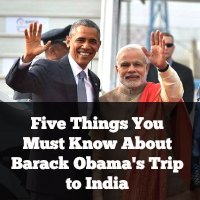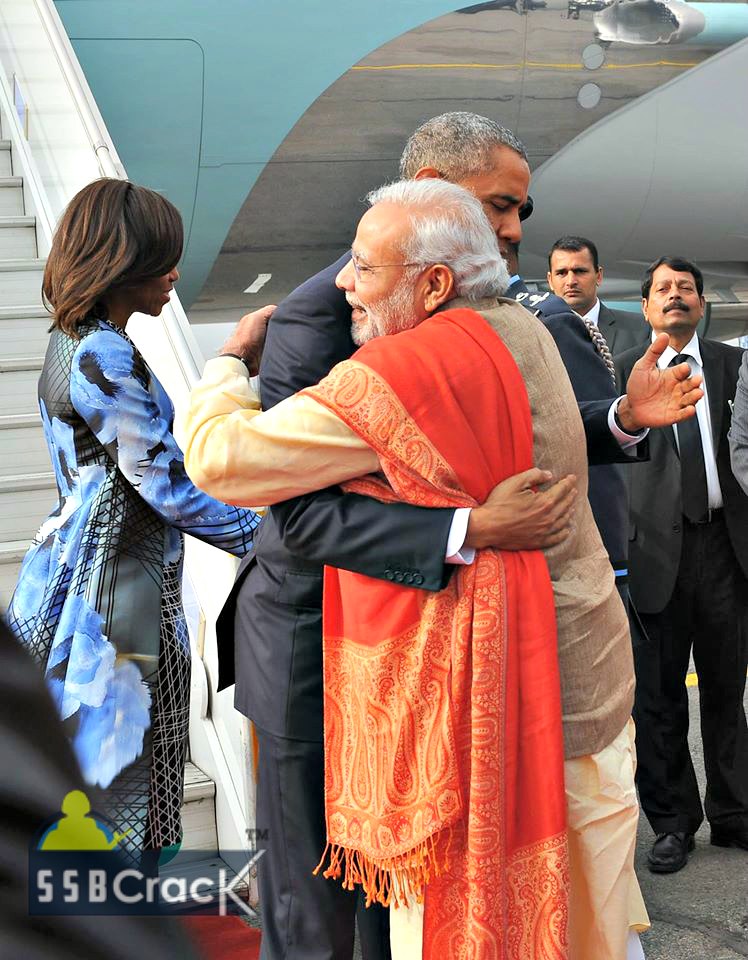President Barack Obama is India’s chief guest on 26th Jan 2015 66th republic day. Indian prime minister Narendra Modi invited President Barack Obama as a chief guest which was accepted by Mr. President. Obama arrived in India on Sunday to be the chief guest at the country’s Republic Day parade – the first time a US president has been honoured in this way. It will also mark the first time that a sitting US president has twice visited India. So, amid all the talk of “natural partners” and “relationships that will define the 21st Century” what can we expect during the three-day visit?
Red Carpet
India has been getting very excited about Mr Obama’s arrival – the nation loves celebrities and VIPs, and stories about their entourages of bodyguards – and the country enjoys the way the visit underscores its increasing emergence.
But probably more important than Mr Obama’s current trip, was Indian Prime Minister Narendra Modi’s visit to Washington last autumn, on the heels of the UN General Assembly. That followed a decade in which Mr Modi himself had been denied a visa over accusations that he had failed in 2002 to prevent the massacre of hundreds of Muslims in Gujarat, where he was chief minister. With nations such as Germany, Japan and Brazil extending invitations to Mr Modi, who was elected in a landslide last May, the US was keen to stress that a new phase of the India-US relationship could begin.
Alyssa Ayres, who served in the US state department as a South Asia expert and who is now a senior fellow at the Council on Foreign Relations, said this week that despite his treatment over the visa issue, Mr Modi did not possess the same knee-jerk wariness of the US that had influenced other India premiers. “Modi does not have any of the hang-ups that previous Indian leaders did,” she said.
What does US want?
The US really wants India to open up its markets – to global retail, legal services and insurance. At the moment, despite constant lobbying, there are strict limits on foreign direct investment. The US is also keen to press ahead with developing India’s clean energy infrastructure, an area which Delhi is keen to make a priority, and Mr Obama wants India to agree to support a carbon emissions deal ahead of global climate talks in Paris at the end of the year.
India has become the third total carbon emitter, even though its per capita emissions are a fraction of those of the West. It has always resisted calls for a cap to emissions, saying that with hundreds of millions of citizens living off a dollar or two a day, its economic development must be a priority. Intellectual property rights will be discused.
The US is always keen to push India as a regional strategic counterweight to China and US arms dealers love to tell Indian officials how vulnerable they are. So much so, that India is the world’s largest purchaser of weapons and the US is its biggest supplier.
“I anticipate a breakthrough on defence. The two sides will most likely sign a new, ten-year defence framework agreement, which will deepen military-to-military ties,” said Milan Vaishnav, an India expert at the Carnegie Endowment for International Peace. “In line with this, there are heightened expectations that the two sides will finally agree on a piece of military hardware to jointly develop and produce.”
India’s wishes :
In exchange for closer ties – a breaking of its traditional policy of non-alignment – India will be pressing the US for greater cooperation on terrorism and access to high-technology goods for civilian and military use. It is also always keen for the US to speak out about those elements in Pakistan which continue to support anti-Indian militancy and cross-border attacks in Afghanistan, a country India is developing close ties with.
“Foreign crises will form a big part of the discussion between Obama and Modi,” analyst Seema Sirohi wrote in a recent briefing for the Indian Council on Global Relations.
“The turmoil in the Muslim world at large, the rise of Isis, the recruitment of youth through the internet, the Afghanistan-Pakistan situation and China – all of these point for greater cooperation between the US administration and India.”
At a broader level, India would welcome any US recognition of its emergence as a global player. When Mr Obama visited Delhi in November 2010, he told the joint houses of parliament he supported India becoming a permanent member of UN Security Council.
Strip-search :
It is barely a year since India-US relations were badly derailed following an unlikely incident surrounding the arrest of an Indian diplomat in New York who was accused of lying on forms about her children’s nanny. Indians were horrified and insulted to learn that one of its envoys was arrested, strip searched and treated like a common criminal. Americans, no strangers to the notion of exceptionalism when it suits them, said the diplomat should have obeyed the rules.
The incident underscored genuine cultural differences between the two countries. Indian officials often feel they are bullied at international forums, while officials of other nations claim Indians are awkward and want special treatment. One issue of potential huge benefit to both countries – but which they cannot appear to solve relates to the landmark civilian nuclear deal signed in 2008. There are billions of potential dollars to be secured, but things are being held up by India’s reluctance to pass legislation that would protect suppliers from liability in the event of a nuclear accident.
Camels:
The air in Delhi has become increasingly bad and some days the pollution can be worse than that in Beijing. But a sunny afternoon during the Indian winter is a wonderful, special pleasure, perhaps the best time of year to visit the country. In addition to be flattered and fawned upon and Indians going giddy about the visit despite themselves, Mr Obama will also be special guest at the Republic Day celebrations.
The day marks the date on which the Constitution of India came into force on 26 January 1950 and India marked its formal emergence as a independent republic. (One of the writers of the constitution, Bhimrao Ramji Ambedkar, was a post-graduate student at New York’s Columbia University).
“The US is central to Modi’s economic and developmental programme, not to speak of regional security,” said Indian journalist Ashok Malik. “By the very act of inviting Obama for Republic Day, he is sending a clear and clear-headed signal of that, including to naysayers in his system.”
Mr Obama may or may not find the march-past of of soldiers and tanks and floats along Delhi’s Rajpath to his taste, but it is a rare person who is not entertained and delighted by the sight of the soldiers of the Border Security Force on the backs of their smartly attired camels – one of just a handful of units in the world that still use these animals.
Also Read
.png) About SSBCrack Editorial Team
About SSBCrack Editorial TeamThe Editorial Team of SSBCrack consists of a group of Professional writers and aspirants. Their main aim is to provide up to date information regarding SSB Interviews and sharing quality information about Indian Defence to help aspirants. Mail us to join our editorial team now.













